
Thomas Gainsborough was an English portrait and landscape painter, draughtsman, and printmaker. Along with his rival Sir Joshua Reynolds, he is considered one of the most important British artists of the second half of the 18th century. He painted quickly, and the works of his maturity are characterised by a light palette and easy strokes. Despite being a prolific portrait painter, Gainsborough gained greater satisfaction from his landscapes. He is credited as the originator of the 18th-century British landscape school. Gainsborough was a founding member of the Royal Academy.

The National is the national art gallery of Scotland. It is located on The Mound in central Edinburgh, close to Princes Street. The building was designed in a neoclassical style by William Henry Playfair, and first opened to the public in 1859.
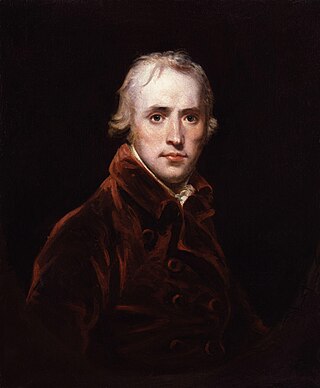
John Hoppner was an English portrait painter, much influenced by Reynolds, who achieved fame as a brilliant colourist.

George Stubbs was an English painter, best known for his paintings of horses. Self-trained, Stubbs learnt his skills independently from other great artists of the 18th century such as Reynolds and Gainsborough. Stubbs' output includes history paintings, but his greatest skill was in painting animals, perhaps influenced by his love and study of anatomy. His series of paintings on the theme of a lion attacking a horse are early and significant examples of the Romantic movement that emerged in the late 18th century. He enjoyed royal patronage. His painting Whistlejacket hangs in the National Gallery, London.

The Courtauld Gallery is an art museum in Somerset House, on the Strand in central London. It houses the collection of the Samuel Courtauld Trust and operates as an integral part of the Courtauld Institute of Art.

Mr and Mrs Andrews is an oil on canvas portrait of about 1750 by Thomas Gainsborough, now in the National Gallery, London. Today it is one of his most famous works, but it remained in the family of the sitters until 1960 and was very little known before it appeared in an exhibition in Ipswich in 1927, after which it was regularly requested for other exhibitions in Britain and abroad, and praised by critics for its charm and freshness. By the post-war years its iconic status was established, and it was one of four paintings chosen to represent British art in an exhibition in Paris celebrating the Coronation of Queen Elizabeth II in 1953. Soon the painting began to receive hostile scrutiny as a paradigm of the paternalist and capitalist society of 18th-century England, but it remains a firm popular favourite.
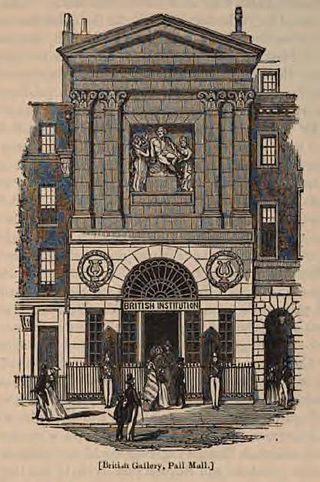
The British Institution was a private 19th-century society in London formed to exhibit the works of living and dead artists; it was also known as the Pall Mall Picture Galleries or the British Gallery. Unlike the Royal Academy it admitted only connoisseurs, dominated by the nobility, rather than practising artists to its membership, which along with its conservative taste led to tensions with the British artists it was intended to encourage and support. In its gallery in Pall Mall the Institution held the world's first regular temporary exhibitions of Old Master paintings, which alternated with sale exhibitions of the work of living artists; both quickly established themselves as popular parts of the London social and artistic calendar. From 1807 prizes were given to artists and surplus funds were used to buy paintings for the nation. Although it continued to attract members and visitors, in 1867, when the lease on its quarters expired, instead of renewing the society wrapped up its affairs.

Julius Caesar Ibbetson was a British 18th-century landscape and watercolour painter.

John Bagnold Burgess was an English artist known for his paintings of historical and genre scenes, principally in Spain.

Gainsborough Dupont was a British artist, the nephew and pupil of Thomas Gainsborough, R.A.

Mrs. Richard Brinsley Sheridan (1787) is an oil on canvas portrait painted by Thomas Gainsborough between 1785 and 1787. It was acquired by the National Gallery of Art in 1937. Mrs. Sheridan was a talented musician who enjoyed professional success in Bath and London before marrying Richard Brinsley Sheridan in 1773 and abandoning her career. She was 31-33 when she sat for Gainsborough, dying from tuberculosis seven years later at the age of thirty-eight. The portrait was painted between 1785 and 1787, and, was exhibited at Gainsborough's studio at Schomberg House, Pall Mall in 1786.

Gainsborough's House is the birthplace of the leading English painter Thomas Gainsborough. It is now a museum and gallery, located at 46 Gainsborough Street in Sudbury, Suffolk, England. It is a Grade I listed building. Some of the pictures on display have been acquired with the help of the Art Fund.
Mary Woodall CBE also known as "Mighty Mary" (1901–1988) was a British art historian, museum director, and Thomas Gainsborough scholar.
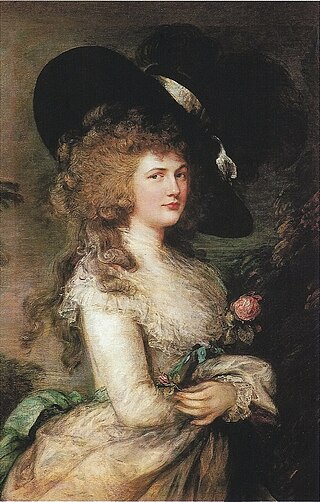
Portrait of Georgiana, Duchess of Devonshire is a portrait painting by the English painter Thomas Gainsborough of the political hostess Georgiana Cavendish, Duchess of Devonshire. It was painted between 1785 and 1787.

The Graham Children is an oil painting completed by William Hogarth in 1742. It is a group portrait depicting the four children of Daniel Graham, apothecary to King George II. The youngest child had died by the time the painting was completed.

Musidora: The Bather 'At the Doubtful Breeze Alarmed', also known as The Bather, is a name given to four nearly identical oil paintings on canvas by English artist William Etty. The paintings illustrate a scene from James Thomson's 1727 poem Summer in which a young man accidentally sees a young woman bathing naked and is torn between his desire to look and his knowledge that he ought to look away. The scene was popular with English artists as it was one of the few legitimate pretexts to paint nudes at a time when the display and distribution of nude imagery was suppressed.
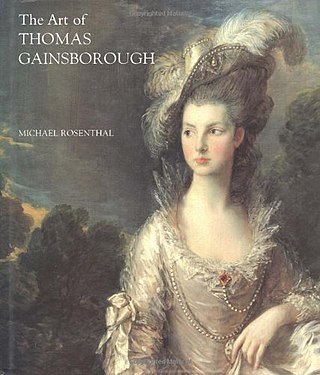
Michael J. Rosenthal is emeritus professor of the history of art at the University of Warwick. He is a specialist both in British art and culture of the eighteenth and early nineteenth centuries, and the arts of early colonial Australia.

Mr and Mrs William Hallett is a 1785 oil on canvas painting by the British painter Thomas Gainsborough, and is now in the collection of the National Gallery in London.
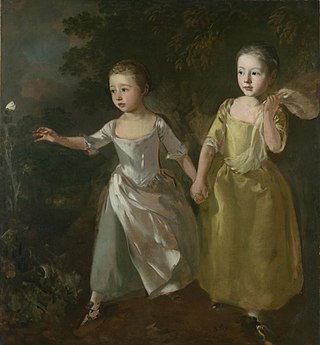
The Painter's Daughters Chasing a Butterfly is a painting by Thomas Gainsborough. It was created sometime in 1756 and is now in the collection of the National Gallery in London.

Gainsborough Lane is a rural road in the South East Area, Ipswich which has been noted for its charm since the nineteenth century. In 1888 John Ellor Taylor, curator of Ipswich Museum, described it as the "dearest walk" available locally for Ipswich people.



















